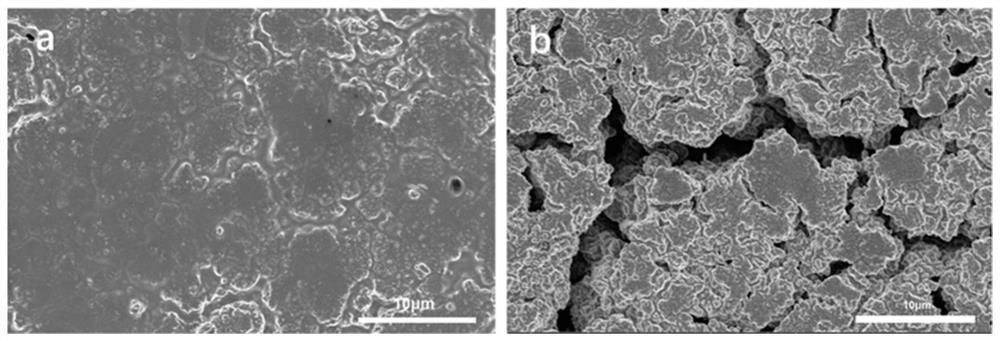Negative electrode self-healing adhesive as well as preparation method and application thereof
A self-healing and adhesive technology, applied in negative electrodes, battery electrodes, active material electrodes, etc., can solve the problems of poor mechanical properties of negative materials, incomplete electrode structure, affecting battery capacity and cycle performance, etc. The effect of broadening the application temperature range, high mass load, improved capacity retention and cycle stability
- Summary
- Abstract
- Description
- Claims
- Application Information
AI Technical Summary
Problems solved by technology
Method used
Image
Examples
Embodiment 1
[0059] (1) Add 2g of 2-amino-4-hydroxy-6-methylpyrimidine (UPy) into 50mL of anhydrous dimethyl sulfoxide, and stir at 150°C for 10 minutes. After UPy is dissolved, the solution is cooled to Room temperature and 3.224 g of 2-isocyanatoethyl methacrylate (ICEMA) were added to the flask. The mixture was rapidly cooled using an ice bath, upon cooling a white solid precipitated. The precipitate was collected and washed three times with excess acetone, and dried under vacuum at 30 °C for 4 h to give the monomer 2-(3-(6-methyl-4-oxo-1,4-dihydropyrimidin-2-yl ) ureido) ethyl methacrylate (UPyMA) (90% conversion).
[0060] (2) According to acrylic acid (AA), polyethylene glycol monomethyl ether methacrylate (PEGMA), 2-(3-(6-methyl-4-oxo-1,4-dihydropyrimidine-2- 1.368g of acrylic acid (AA) and 0.3g of polyethylene glycol monomethyl ether methacrylate (PEGMA) at a molar ratio of 95:3:2. Dissolve in a mixed solvent of 8.434mL water and N,N-dimethylformamide (volume ratio: 1:1), form a...
Embodiment 2
[0066] (1) Add 2g of 2-amino-4-hydroxy-6-methylpyrimidine (UPy) into 50mL of anhydrous dimethyl sulfoxide and stir at 150°C for 10 minutes. After UPy dissolves, cool the solution to Room temperature and 3.224 g of 2-isocyanatoethyl methacrylate (ICEMA) were added to the flask. The mixture was rapidly cooled using an ice bath, upon cooling a white solid precipitated. The precipitate was collected and washed three times with excess acetone, and dried under vacuum at 30 °C for 4 h to give the monomer 2-(3-(6-methyl-4-oxo-1,4-dihydropyrimidin-2-yl ) ureido) ethyl methacrylate (UPyMA) (90% conversion).
[0067] (2) According to acrylic acid (AA), polyethylene glycol monomethyl ether methacrylate (PEGMA), 2-(3-(6-methyl-4-oxo-1,4-dihydropyrimidine-2- 1.368g of acrylic acid (AA) and 0.3g of polyethylene glycol monomethyl ether methacrylate (PEGMA) at a molar ratio of 95:3:2. Dissolve in a mixed solvent of 8.434mL water and N,N-dimethylformamide (volume ratio: 1:1), form a homogene...
Embodiment 3
[0073] (1) Add 2g of 2-amino-4-hydroxy-6-methylpyrimidine (UPy) into 50mL of anhydrous dimethyl sulfoxide and stir at 150°C for 10 minutes. After UPy dissolves, cool the solution to Room temperature and 3.224 g of 2-isocyanatoethyl methacrylate (ICEMA) were added to the flask. The mixture was rapidly cooled using an ice bath, upon cooling a white solid precipitated. The precipitate was collected and washed three times with excess acetone, and dried under vacuum at 30 °C for 4 h to give the monomer 2-(3-(6-methyl-4-oxo-1,4-dihydropyrimidin-2-yl ) ureido) ethyl methacrylate (UPyMA) (90% conversion).
[0074] (2) According to acrylic acid (AA), polyethylene glycol monomethyl ether methacrylate (PEGMA), 2-(3-(6-methyl-4-oxo-1,4-dihydropyrimidine-2- 1.031g of acrylic acid (AA) and 0.895g of polyethylene glycol monomethyl ether methacrylate (PEGMA) at a molar ratio of 80:10:10. Dissolve in a mixed solvent of 7.160mL water and N,N-dimethylformamide (volume ratio 1:1), form a homog...
PUM
| Property | Measurement | Unit |
|---|---|---|
| diameter | aaaaa | aaaaa |
Abstract
Description
Claims
Application Information
 Login to View More
Login to View More - R&D
- Intellectual Property
- Life Sciences
- Materials
- Tech Scout
- Unparalleled Data Quality
- Higher Quality Content
- 60% Fewer Hallucinations
Browse by: Latest US Patents, China's latest patents, Technical Efficacy Thesaurus, Application Domain, Technology Topic, Popular Technical Reports.
© 2025 PatSnap. All rights reserved.Legal|Privacy policy|Modern Slavery Act Transparency Statement|Sitemap|About US| Contact US: help@patsnap.com



